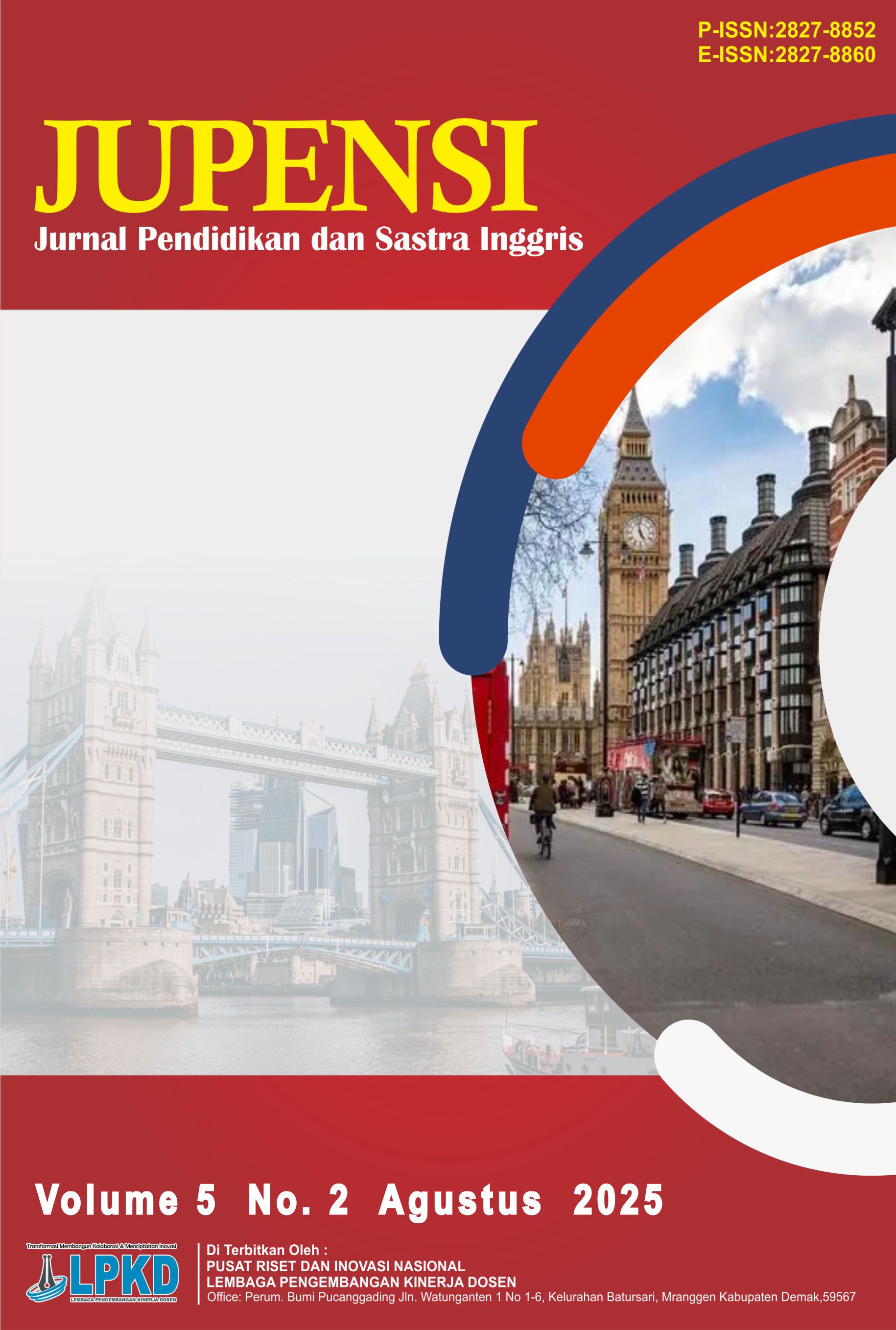The Use of Code Mixing by The Javanese People in Gerokgak Village
DOI:
https://doi.org/10.55606/jupensi.v5i2.5050Keywords:
Code, Mixing, SocietyAbstract
The aim of this research was to analyze the code mixing used by Javanese people in Gerokgak village. The things that were analyzed were the types of code mixing and the reasons for code mixing. The types of code mixing used the theory of (Suwito, 1983) and the reasons for code mixing used the theory of (Hoffmann, 1991) and interviews. This research method was qualitative descriptive. Data collection used observation and interview techniques, then for data analysis techniques used the theory of (Milles & Huberman, 1994). Based on the results of the study, the types of code mixing that occurred were inner code mixing and outer code mixing. The inner code mixing was the dominant type that contained 56 data and the outer code mixing contained 37 data. The reasons for code mixing obtained were Talking about particular topics contained 71 data, being emphatic about something contained 3 data, interjection contained 1 data, repetition used for clarification contained 2 data and expressing group identity contain 19 data. Based on the interview of the participants, reasons they used code mixing were because they live in mixed societies, for daily communication with people, because the community uses different languages, and adjusting to the interlocutor. Based on the results of the study, it can be concluded that code mixing appears in the participants' conversations with various types and reasons.
Downloads
References
Aronin, L., & Singleton, D. (2012). Multilingualism. John Benjamins Publishing Company.
Azis, H. N., & Rahmawati, L. E. (2021). Alih Kode dan Campur Kode dalam Pembelajaran . Jurnal Bahasa Indonesia, 62.
Brown, K., & Ogilvie, S. (2009). Concise Encyclopedia of Languages of the World. Oxford: Elsevier.
Carter, N. (2014). The Use of Triangulation in Qualitative Research. Oncology Nursing Forum, 545.
Cenoz, J., & Genesee, F. (1998). Beyond Bilingualism : Multilingualism and Multilingual Education. Clevedon: Multilingual Matters.
Edwards, J. (1994). Multilingualism. London: Routledge.
Fasold, R. W., & Linton, J. C. (2006). An Introduction to Language and Linguistic. New York: Cambridge University Press.
Hales, D. (2010). An Introduction to Triangulation. Geneva: UNAIDS Monitoring and Evaluation Fundamentals.
Hamers, J. F., & Blanc, M. H. (2000). Bilinguality and Bilingualism. Cambridge: Cambridge University Press.
Hoffmann, C. (1991). An intoduction to Bilingualism. New york: Longman inc.
Holmes, J. (2013). An Intoduction to Sociolinguistics fourth edition. New York: Routledge.
Hudson, R. (1996). Sociolinguistics second edition. Cambridge University Press.
Irrohman, A. T., & Rokhman, F. (2021). Alih Kode dan Campur Kode dalam Ceramah Habib Al-Muthohhar. Jurnal Sastra Indonesia, 51.
Maher, J. C. (2017). Multilingualism: A Very Short Introduction. Oxford University Press.
Milles, M. B., & Huberman, A. M. (1994). Qualitative Data Analysis. London: SAGE publications.
Mufadhdhal, D. R., et al. (2020). The Code-Mixing on the Trials in the Madiun Military. Semantiks, 105.
Muslimin, A. I. (2020). Code-Mixing of Javanese Language and Bahasa Indonesia in the Friday Prayer Sermon At Miftahul Hidayah Mosque, Pendem Village, City of Batu, East Java. Mabasan, 294.
Muysken, P. (2000). Bilingual Speech A Typology of Code-Mixing. Cambridge: Cambridge University press.
Nababan. (1993). Sosiolinguistik suatu pengantar. Jakarta: Gramedia Pustaka Utama.
Poedjosoedarmo, S. (2013). Tingkat Tutur Bahasa Jawa. Yogyakarta: Kementerian Pendidikan Dan Kebudayaan Badan Pengembangan Dan Pembinaan Bahasa Balai Bahasa Provinsi Daerah Istimewa Yogyakarta.
Putri, D. D., & Pulungan, R. (2022). Analisis Alih Kode dan Campur Kode Bahasa Jawa dan Bahasa Indonesia Dalam Interaksi Warga Desa Namo Bintang Dusun Ii Sumberingin. Jurnal Pendidikan Bahasa dan Sastra Indonesia, 55.
Rahima, A., & Tayana, N. A. (2019). Campur Kode Bahasa Indonesia Pada Tuturan Berbahasa . Jurnal Ilmiah Pendidikan Bahasa dan Sastra Indonesia, 141.
Romaine, S. (2001). Language and Society an Introduction to Sociolinguistics second edition. New York: Oxford University Press.
Scotton, C. M. (2006). Multiple Voices An Introduction to Bilingualism. Blackwell Publishing Ltd.
Sinaga, M. T., et al. (2022). Karakteristik Campur Kode dan Alih Kode pada Masyarakat Tutur di Pasar Tanah Jawa. Jurnal Bahasa dan Sastra Indonesia, 119-120.
Sundoro, B. T., et al. (2018). Campur Kode Bahasa Jawa Banyumasan dalam Pembelajaran Bahasa Indonesia. RETORIKA, 137-138.
Suwito. (1983). Pengantar Awal Sosiolinguistik: Teori dan Problema. Surakarta: Henary Offset.
Trudgill, P. (2000). Sociolinguistics: An Introduction to Language and Society. Penguin Books.
Umaidah, et al. (2021). Analisis Alih Kode dan Campur Kode Pada Pembelajaran Bahasa Indonesia Kelas VIII di Mts. Mujahidin Sambong. Jurnal Pendidikan Edutama, 8.
Wardhaugh, R. (2006). An Introduction to Sociolinguistics. Blackwell Publishing.
Zuhri, S. M., et al. (2019). Campur Kode dan Alih Kode Bahasa Jawa-Riau Oleh Masyarakat Transmigran Jawa di Riau. Sabdasastra, 9-10.
Downloads
Published
How to Cite
Issue
Section
License
Copyright (c) 2025 Jurnal Pendidikan dan Sastra Inggris

This work is licensed under a Creative Commons Attribution-ShareAlike 4.0 International License.









